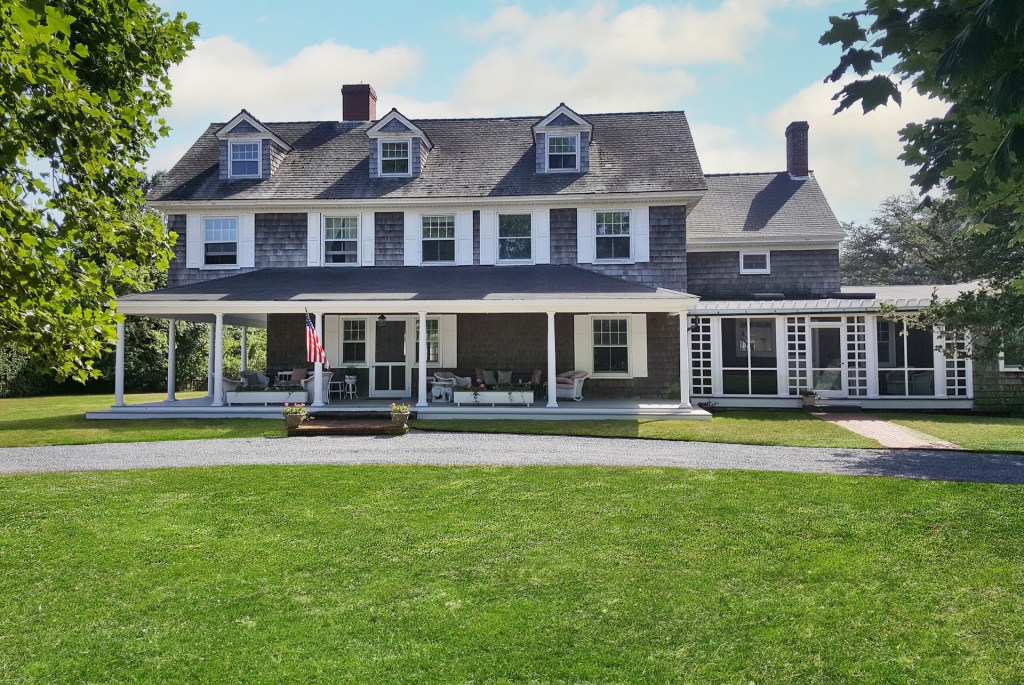Vista vs Patch: How 'A Man’s Castle' Put an End to Horizon Views

Every year there is somebody in the Hamptons who is pushing to rope off a wide-open space, border it with hedgerows and keep everybody out so just they and their friends can look at the space alone. From the inside. So it’s not much of a space anymore, but just something that has to be mowed and landscaped.
“Wait until you see this garden I have created,” they toot. It could now include an artificial pond stocked with fish—real fish—a park bench, some sculpted hedges, a tennis court and swimming pool. They give you the code to the front gate. You drive up. Is this the right house? Enter the code and we’ll see. Presto! The gates swing open and there you are in the world that the master of the universe—or the mistress of the universe—has created.
All this is well and good for them and their friends, but the truth is that it is one more bite out of the magnificent open communal space that is the Hamptons and that so fascinated them that they thought they ought to come out here in the first place. They are indeed masters of all they survey. But it isn’t much at all, frankly, when you compare it to the whole.
The Hamptons still is, for the most part, what it has always been. Mists still hover over the vast vineyards and potato fields. Bays, ponds, farms and the seas are everywhere. Sunset views can be seen over water. People go out clamming, or sailing. They lie out on the beaches and feel the wind sliding over their bodies. Animals still roam (sorry about that).
Our towns and villages are fierce defenders of open space. Huge sums of money are now being spent to save open lands, the money coming—rather ingeniously—from a 2% tax levied on all real estate sales in excess of $250,000.
Nevertheless, the trend continues. You never hear of someone buying a property, taking an addition off the house to make it a more modest size, tearing out the fences and hedgerows, planting indigenous foliage and opening it up for all to enjoy, including the occupants now in residence.
A concept that involves wealthy people walling themselves off is hard to understand when thinking about the Hamptons. Is crime rampant? Are they afraid they will experience burglary? Is this about stalkers? Do they really NOT want to see the rest of the Hamptons except when they go “out?”
Guess what? If the trend gets to a tipping point, the Hamptons will lose what we all love about it. Arriving here, an individual with a McMansion in the Hamptons surrounded by hedgerows could be anywhere. It could be Bayonne, New Jersey. Same thing. Hedges, flowers, pond, tennis, pool. Think about it.
The first group of rich people who settled in the summertime out here understood what they had. This was the WASP community. They would come out east to enjoy the air and waters of the Hamptons from great summer mansions they built down by the sea. You could drive along Meadow Lane or Lily Pond Lane or many another lane and see them, one after another, visible to their next-door neighbor a few hundred yards away and, for the most part, visible to those driving by.
As for the rest, take a ride in a car over the hills of the Old Montauk Highway and try to look down at the ocean. You once could see the beach. Go up to the lookout east of the Deep Hollow Ranch out at Montauk and try to look out. The view is now just foliage. Drive along Hedges Lane a mile from the Atlantic Ocean and try to see the ocean mist billowing over the dunes onto the farm fields of Sagaponack. You can see nothing but the hedgerows. The Hedges family was one of the founding families in Bridgehampton. Now people think the lane was named after the hedgerows.
One of the most startling new developments in this situation is what is happening at Beach Hampton, just east of Amagansett. A road runs along parallel to the dunes there. In years past, you could drive along that road and see modest, modern beach houses, each on an acre or two, facing out to the sea on one side and out to the road on the other. Driving by, you could see the ocean occasionally. You’d know it was there. You could park along that road and walk through the dunes to the beach.
I was down there one recent Saturday afternoon. Many beach houses have been razed and replaced with massive, private gated homes. Where the walkthroughs from the road to the beach are, you will now find someone sitting in a chair at a folding table who will stop you. The walkways are for the use of the residents of the Beach Hampton Association only. Are you such a member? Sorry, you can’t be allowed through.
Of course, there are No Parking signs all along that road now. And there are even speed bumps to let you know you are really not welcome here.
Also, this is the community where the group of some 100 property owners with newly built homes filed a lawsuit against the town, hoping to keep you from driving on the beach and being a “nuisance,” which could mean even walking along the ocean beach for the quarter mile where the new houses are, let alone fishing, beach driving or sunbathing.
These homeowners hired top-of-the-line lawyers to sift through the legal documents that have been written to accompany the legal transfers of the deeds in this area from one person to another during the last 300 years. They hoped they could find a document that fails to properly state that the transfer includes the restrictions that keep property owners from excluding town residents.
Their goal? They want, as a small group, “sole and complete possession of subject property be awarded to plaintiffs (and that) all persons be forever barred from all claims to right to use subject property (and) a permanent injunction against all persons from utilizing subject property as a bathing beach.”
A few weeks ago, a State Supreme Court judged ruled for the local people, dismissing the claim. But there’s still a chance the locals can lose, depending on the appeals process.
Here’s a website for the private group that aims to prevent this from happening, not only here at this beach but at all other beaches in this town—go to citizensforaccessrights.com. “Join the fight to preserve public beach access for everyone, not just a select few,” they write. “Citizens for Access Rights strives to protect all forms of public beach access and to preserve the rights and traditions provided to residents since colonial times.”
Among other things you can do on this site is sign a petition encouraging the Town Board to follow through on their vow to condemn this beach and turn it into a facility for the public in the event that the appeals court overturns the judges’ decision.



